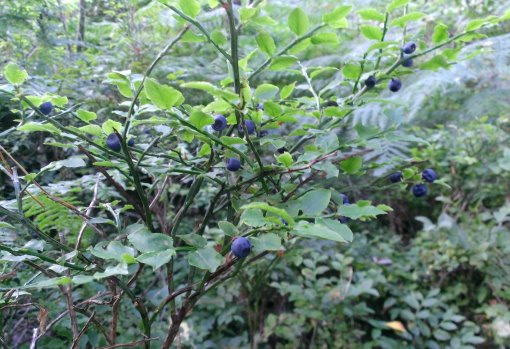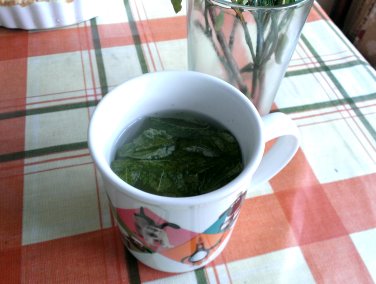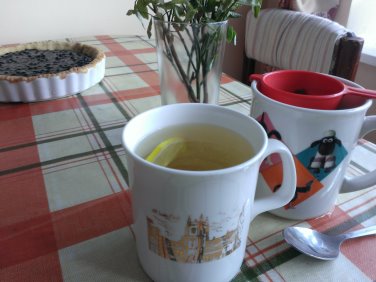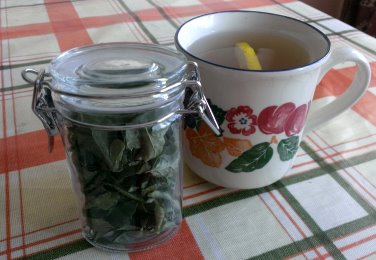Bilberry Pie And Bilberry Leaf Tea
By Mike on Monday, August 12, 2013, 22:46 - Permalink
 Bilberries are good this year - let's take a look at a couple of uses for this plant - Bilberry Tart and Bilberry Leaf Tea.
Bilberries are good this year - let's take a look at a couple of uses for this plant - Bilberry Tart and Bilberry Leaf Tea.
What Are Bilberries?
Vaccinium myrtillus - Bilberries, also known as Blaeberries, Whortleberries, Hurts or Whinberries are - in all but name - northern European blueberries. They're smaller than American highbush blueberries - with fruits up to about one centimetre in diameter, growing on wiry plants that range in size from ankle-high scrub to willowy, waist-high bushes.
The fruits are quite acidic in taste, delicately aromatic and juicy - the pulp and juice of the fruit is a deep maroon-purple colour throughout, indelibly staining everything it touches.

Bilberry Tart
This is a really delicious tart, deep and packed to the brim with fruit - easy to make, but sure to impress.
Start with a 9 inch sweet shortcrust pastry case (I'm not going to bother with the recipe for the pastry, as it's easy to look up - or if you want, you can easily just buy a precooked flan case)
Put about 350g of fresh bilberries in a saucepan - add the juice of one lemon and about 75g of sugar.
Bring to a gentle simmer, starting over a very low heat. The berries will burst and release a lot of juice - as this happens, you can turn up the heat a little and stir to dissolve the sugar. Taste and add a little more sugar if you think it's not sweet enough, but don't over-sweeten or you will overwhelm the delicious crisp acidity of the fruit.
While the fruit is heating, put four teaspoons of cornflour in a cup and add a quarter cup of cold water - stir to mix to liquid consistency.
The moment the fruit starts to bubble, pour in the cornflour mixture, stirring vigorously as you add it - keep stirring and heating and in the space of less than a minute, the fruit mixture will thicken dramatically.
Remove from the heat and pour the contents of the pan into the flan case - use a spatula to scrape everything out of the pan, then (if necessary) spread the fruit mixture out evenly in the pastry case.
Leave to cool for at least an hour - ideally longer - it should set to a thick, silky jelly-like texture - just thick enough not to run away when the pie is cut into wedges. Serve with something creamy - for example ice cream, clotted cream or mascarpone cheese.

Bilberry Leaf Tea
 This was a bit of an experiment - some of my wild food books mention bilberry leaf tea in passing, or talk a little about the supposed health benefits of drinking it, but say little or nothing about the method of preparing it, or what it tastes like.
This was a bit of an experiment - some of my wild food books mention bilberry leaf tea in passing, or talk a little about the supposed health benefits of drinking it, but say little or nothing about the method of preparing it, or what it tastes like.
So at the end of a productive day of berry-picking, I cut (from a place where the bushes were growing in very great abundance) a couple of sprigs of bilberry leaves to take away. On returning home, I stood them in an empty glass and placed it on a windowsill to dry.
 The next day - quicker than I expected - the leaves had dried out. They were crisp and rustling, but not crumbly or brittle.
The next day - quicker than I expected - the leaves had dried out. They were crisp and rustling, but not crumbly or brittle.
So I set about making my first cup of bilberry leaf tea.
 I picked about 20 leaves and placed them in a mug of boiling water.
I picked about 20 leaves and placed them in a mug of boiling water.
I left this to steep for 5 minutes, then poured it through a strainer into a fresh mug, to which I added a thin slice of lemon.
 The end result is a pale straw-green beverage with a pleasant, slightly fruity aroma.
The end result is a pale straw-green beverage with a pleasant, slightly fruity aroma.
To taste, the drink is a little similar to green tea - pleasantly astringent and refreshing, ever so slightly tannic with an intriguing fresh, fruity-leafiness - something like a blend of tea, green apple and the subtle forest aroma of the bilberries themselves.
Altogether a very nice and refreshing drink.
 The dried leaves strip very easily from the twigs - although if I was picking them in greater quantity, I would not have cut whole stalks - as I suspect the leaf-stripped stems would sprout new leaves if left on the plant.
The dried leaves strip very easily from the twigs - although if I was picking them in greater quantity, I would not have cut whole stalks - as I suspect the leaf-stripped stems would sprout new leaves if left on the plant.
The dry leaves can be stored in an airtight jar for later use.
